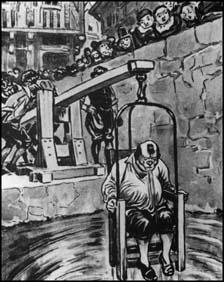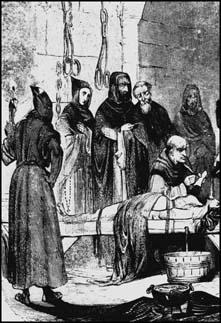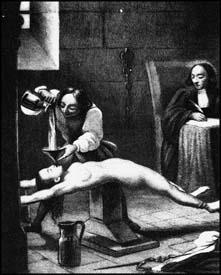The Big Book of Pain: Torture & Punishment Through History (43 page)
Read The Big Book of Pain: Torture & Punishment Through History Online
Authors: Daniel Diehl

Boiling.

Ducking stool.
DUCKING
Although the punishment of ducking women in the local pond came into use in southern England as early as the Anglo-Saxon period, when it was known as the
scealding
(or scolding) stool, ducking came into its own during the Middle Ages when its use spread throughout England and Europe. During this period prostitutes and shrewish women were publicly punished in ways ensured to teach them a lesson in decorum and good manners without inflicting permanent, bodily harm. One of the more popular methods of teaching a
communis rixatrix
(common scold) to hold her tongue was by giving her a good ducking in the local lake or mill pond. Slanderers and what were known as ‘makebayts’ (gossips) were subjected to the same treatment. The condemned was tied to a chair, or stool (commonly called a ‘ducking stool’ but properly termed a ‘scolding stool’, ‘trebucket’ or ‘castigatory’) to which two ropes were tied. Woman and stool were then heaved into the water and immediately dragged to the safety of dry land.
At some sites where duckings seem to have been carried out fairly regularly the ducking stool was permanently affixed to the end of a long, counterbalanced pole, much like a see-saw. With such advanced technology three or four stout lads could submerge and retrieve a nagging woman in a matter of ten or fifteen seconds. The main point of this exercise was to subject the victim to as much public humiliation as possible. Once she had become a figure of derision and jokes, it was hoped that her snide tongue would, hopefully, lose its sharp edge. Ducking should not be confused with the ‘swimming’ of suspected witches. (See opposite.)

Tortue of the funnel.
KEELHAULING
This uniquely naval punishment meant exactly what its name implies: the victim was dragged beneath a ship, along or across the keel (the backbone of the ship that extends beneath the bottom of the hull) and hauled up the other side. When a sailor had committed a crime severe enough to warrant keelhauling, a rope was looped beneath the ship and the condemned man was tied to the rope and then tossed overboard. Appointed members of the crew then hauled in the rope from the opposite side of the ship, effectively dragging the victim across the bottom of the vessel. If the rope was hauled in slowly, the condemned man might sink low enough to avoid having his back ripped to shreds by the sharp shells of the barnacles that attached themselves to the submerged portion of wooden ships, but was in danger of drowning. If, on the other hand, the rope was pulled faster, the time under water was shorter, but the chance of being slashed to pieces by the barnacles was far greater. For the most serious offences, a sailor might be condemned to be keelhauled stern to bow, along the length of the ship, rather than from side to side; this was effectively a death sentence as there is a limit to how long anyone can hold their breath. The first mention of keelhauling is found in Dutch naval records dating from 1560 and the practice was not formally abolished until 1853. Another variation of this torture involved tying a miscreant by his wrists or ankles (or both) and then dragging or ‘towing’ him behind a ship in full sail for a set period of time. The inability of a man to keep his head above water in such circumstances means that this would likely equate to a death sentence – even IF the waters were devoid of sharks.

Baker’s punishment in ducking stool.
SWIMMING
There were many ways to identify a witch but one of the more popular was to ‘swim’ the suspect. As in the practice of ‘ducking’, described above, the victim was either tied to a chair or had bound hands and feet, and tossed into a lake or pond. Unlike ducking, where the dousing only lasted long enough to thoroughly humiliate the victim, swimming required the victim to remain in the water long enough for the judge or clergymen to determine whether or not she was a witch. The prevailing theory of the sixteenth and seventeenth centuries was that water, which was the source of life and the medium used in Christian baptismal rites, was holy and, as such, would not accept an evil person into its depths. With this simple, but ultimately flawed, guideline the determination of guilt or innocence was decided upon by whether the victim floated or sank. If they floated (that is, if the water rejected them) they must be a witch and would be placed on trial as such – usually resulting in execution. If, on the other hand, they sank (and remained submerged long enough to satisfy the judges and bystanders) they must be innocent. Swimming was, invariably, a Catch 22 situation. How many innocent women and men were allowed to drown before they were deemed innocent of witchcraft can never be determined.

Torture of the funnel.

Torture of the funnel
TORMENTO DE TOCA
Drowning, or choking to death, are horrible prospects that make anyone shudder to contemplate. It was this specific fear, and the pain and panic associated with it, that led the Spanish Inquisition to invent a torture known as
Tormento de toca
. In the
Tormento
, the victim was strapped down and then a length of fine-mesh cloth (usually linen) was stuffed down his throat and up his nostrils; not enough so as to suffocate him, but certainly enough to make him panic. Once the cloth was in place, a fine stream of water was allowed to trickle onto the exposed ends of the cloth, causing the moisture to be absorbed into the victim’s throat and nostrils. Once the victim had nearly reached the point of unconsciousness the cloth was removed. According to eye-witness accounts, the extracted cloth was frequently covered with blood and the sensation was reported to be ‘like pulling his bowels through his mouth’. In a nasty variation of this torture a funnel, rather than a rag, was forced down the victim’s throat. Into the funnel more and more water was poured. Instantly the victim would start to gag and retch, but the pouring continued until the victim’s stomach was bloated and distended and the water backed up into their throat and gushed from their mouth. When the victim was ‘full’, a noose was placed around his throat, or a gag inserted into his mouth, to prevent him from vomiting up the water. After removing the poor creature from the torture table, the torture masters rolled him back and forth across the dungeon floor, producing horrible pain in his water-filled stomach. Eventually, the gag, or noose, was removed and the victim was allowed to vomit up the water before being subjected to another round of questioning.
Presumably, some who were subjected to this horrible procedure died from ruptured stomachs or choked to death before they could answer the questions. A similar torture was used in France at the same period, although the horrible abuse of the victim seems not to have been so severe. In the first stage, known as
Question Ordinaire
, the victim had four pints of water funnelled down their throat. If this failed to elicit the desired answers the quantity was doubled and referred to as
Question Extraordinaire
.
TRIAL BY WATER
See section on ‘Torture by Burning and Branding’ under the entry ‘Trial by Fire & Water’.
B
ecause all forms of whipping are, by definition, similar, this section will not be broken down by method but by the types of whips used by various civilisations throughout history. Virtually since the beginning of civilisation, whipping has been employed as one of society’s most common forms of punishment. Generally it has been confined to non-lethal uses but in some instances the whip has proven as lethal as hanging or burning at the stake.
From the time of Ancient Egypt and the Babylonian king, Hamumurabi, (reigned from 1792–1750 BC) up until the present day, virtually every culture has possessed and employed at least some variety of whip to punish wrongdoers. In almost every case the number of lashes to be administered was in direct proportion to the severity of the crime; the more serious the offence the greater the number of lashes.

